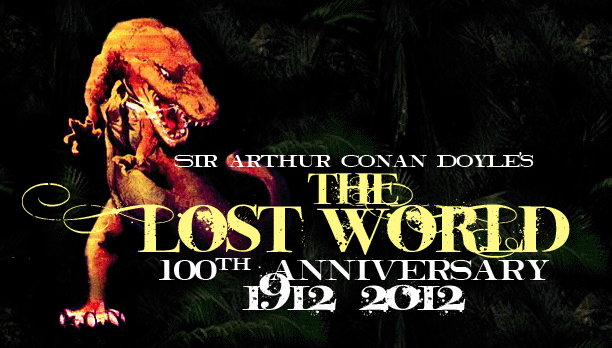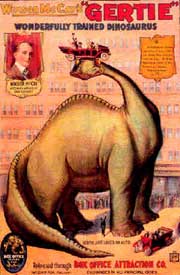

|
Though often cited as the first ever animated cartoon, Gertie the Dinosaur actually falls in quite short. The first was most likely Humorous Phases of Funny Faces in 1906. Winsor McCay himself created two previous animations in 1911's Little Nemo and 1912's How a Mosquito Operates. Gertie is, however, heralded as the first animated character, preceeding such luminaries as Mickey Mouse and Betty Boop.
In 1915, the popularity of Gertie was so huge that John Bray released his own "version" of Gertie, featuring a brontosaurus of his own wreaking havok. Nowhere near as charming as the real Gertie, Bray's creation generally had a mean attitude. The real Gertie was just more curious, and happened to get the upper hand is all! John Bray was known for creating derivative films that were meant to cash in on the popularity of other movies. Even The Lost World itself wasn't safe, as Bray released The Lost Whirl in 1926. These sorts of movies helped to secure Bray's place as perhaps one of the fathers of exploitation B-films.
If you own or rent the DVD of Disney's Dinosaur film, and you're lucky, you might be able to find a secret "easter egg" that shows Gertie the Dinosaur! To find it, "Insert Disc 2, then select 'Development'. Press Right on the next screen to highlight the T-Rex skull and press Enter to see Gertie the Dinosaur." (GameWinners.com)
If you saw Jurassic Park (and who didn't?), you no doubt recall the "Mr. DNA" animated sequence, in which John Hammond interacts with the little redneck genetic fragment. While this was placed in the film to provide a quick and easy explanation for the genetic engineering angle of the film, it was also a tribute to Gertie the Dinosaur. Hammond does a vaudville-like performance similar to the one that Winsor McCay did with Gertie!
|
Now, there's no telling if those events actually happened, but the product of whatever transpired changed the face of cinema forever. Gertie the Dinosaur was, for her time, a totally ingenious venture. McCay created a series of thousands of drawings, each a little different from the one before. Then, using the technology in a way very similar to stop-motion innovator Willis O'Brien, filmed one picture for each frame of film. When played back, it appeared as though this drawn character was really alive.
Released in 1912, Gertie was originally part of a Vaudville stage show in which McCay directed his dinosaur from stage right. Back in 1912, there would be regular programmes called "chalk talks" in which cartoonists would draw on stage from the suggestions of the audience. You can imagine the frenzy when McCay's drawing actually began moving around! Not only could he command Gertie to hop from one foot to the other, or watch helplessly as she toyed with the small mammoth Jumbo, but he even did the amazing by throwing her food and then entering the picture himself! Of course, this was accomplished through careful timing, wherin McCay would throw a pumpkin behind the screen and as he did so, it's animated counterpart would appear onscreen. The same applied for himself. The film promoted itself as the "Greatest Animal Act in the World", and included tag-lines like "Gertie: she's a scream. She eats, drinks and breathes! She laughs and cries. Dances the tango, answers questions and obeys every command! Yet, she lived millions of years before man inhabited this earth and has never been seen since!!" By 1914, the demand to see this novel film increased to the point where McCay created a version that included a live action segment that book-ended the cartoon. It was this segment that told the story of the bet and McCays triumph over McManus. It also featured McCay's original Vaudville instructions to Gertie as intertitle cards.
 This would not be the end of Gertie though! She returned in 1921 in Gertie on Tour, where she ran amok in the modern world... Travelling around the world, she had run-ins with various contraptions like trains and creatures like the modern small toad (you see, in her day, toads were huge, so the small ones frighten her). It ends with Gertie falling asleep and dreaming of the day when she was the life of the party, dancing amongst a group of brontosaurs. Unfortunately, this film is only known in fragments today, a good portion having been lost. You can see those in the following film clip:
But a Gertie ice cream counter in a celebration of Hollywood is a nice tribute, after all, Gertie the Dinosaur is a watershed in the art of cinema. The first silver screen dinosaur, and by far the most charming character ever animated.

|